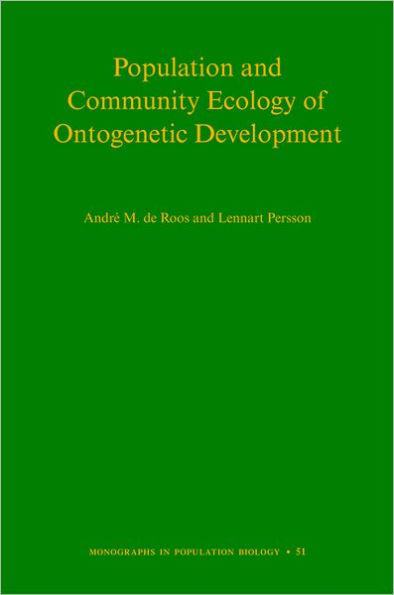
Population and Community Ecology of Ontogenetic Development
552
Population and Community Ecology of Ontogenetic Development
552Hardcover
-
PICK UP IN STORECheck Availability at Nearby Stores
Available within 2 business hours
Related collections and offers
Overview
De Roos and Persson show how the effects of ontogenetic development on ecological dynamics critically depend on the efficiency with which differently sized individuals convert food into new biomass. Differences in this efficiency—or ontogenetic asymmetry—lead to bottlenecks in and thus population regulation by either maturation or reproduction. De Roos and Persson investigate the community consequences of these bottlenecks for trophic configurations that vary in the number and type of interacting species and in the degree of ontogenetic niche shifts exhibited by their individuals. They also demonstrate how insights into the effects of maturation and reproduction limitation on community equilibrium carry over to the dynamics of size-structured populations and give rise to different types of cohort-driven cycles.
Featuring numerous examples and tests of modeling predictions, this book provides a pioneering and extensive theoretical and empirical treatment of the ecology of ontogenetic growth and development in organisms, emphasizing the importance of an individual-based perspective for understanding population and community dynamics.

Product Details
| ISBN-13: | 9780691137575 |
|---|---|
| Publisher: | Princeton University Press |
| Publication date: | 01/15/2013 |
| Series: | Monographs in Population Biology , #51 |
| Pages: | 552 |
| Product dimensions: | 6.20(w) x 9.30(h) x 1.60(d) |
| Age Range: | 18 Years |
About the Author
Table of Contents
Preface ix
Part I - SUMMARY AND INTRODUCTION
1. Summary: A Bird's-Eye View of Community and Population Effects of Ontogenetic Development 3
- Historical Background 3
- Biomass Overcompensation 7
- Ontogenetic (A)Symmetry in Energetics 8
- Emergent Community Effects of Biomass Overcompensation 11
- Ontogenetic Niche Shifts in Consumer Life History 14
- Ontogenetic Niche Shifts in Predator Life History 15
- Competition between Consumers with and without Ontogenetic Niche Shifts 17
- Ontogenetic (A)Symmetry in Energetics and Population Dynamics 19
- Generalization 22
2. Life History Processes, Ontogenetic Development, and Density Dependence 24
- Back to Darwin 24
- Individual- versus Population-Level Assumptions 28
- The Population Dynamical Triad 32
- Growth Patterns and the Ecology of Ontogenetic
- Body-Size Scaling and Magnitude of Body-Size Changes 40
- Changes in Ecological Roles over Ontogeny 44
- Stepping Back—Some Perspectives 45
Development 34
Part II - ONTOGENETIC DEVELOPMENT AND COMMUNITY STRUCTURE
3. Biomass Overcompensation 49
- A Stage-Structured, Bioenergetics Model 50
- Equal Ingestion Rates 64
- Unequal Ingestion Rates 69
- Empirical Evidence 86
- Asymmetry and Life History Effects 90
- More Complicated Life Histories 93
- Ontogenetic Symmetry and Biomass Overcompensation 107
4. Emergent Allee Effects through Biomass Overcompensation 115
- Emergent Allee Effects in Stage-Structured Biomass Models 116
- Emergent Allee Effects in the Kooijman-Metz Model 136
- Size-Structured Predators Foraging on Size-Structured Prey 145
- Empirical Evidence for Emergent Allee Effects 159
5. Emergent Facilitation among Predators on Size-Structured Prey 165
- Generalists Facilitating Specialist Predators 169
- Facilitation between Specialist Predators 175
- Multiple Predators and a Single Prey 186
- Experimental Evidence 188
6. Ontogenetic Niche Shifts 196
- Consumer-Resource Systems 198
- Consequences for Higher Trophic Levels 209
- Ontogenetic Niche Shifts in Predator Life History 226
7. Mixed Interactions 253
- Niche Overlap between Stage-Structured Prey and Predators 256
- Niche Overlap between Size-Structured Prey and Predators 281
- Empirical Studies 292
8. Ontogenetic Niche Shifts, Predators, and Coexistence among Consumer Species 296
- Ontogenetic Niche Shifts and Interspecific Competition 297
- Ontogenetic Niche Shifts in Both Consumers 311
- Effects of Predators on Coexistence of Consumers 317
Part III - ONTOGENETIC DEVELOPMENT AND COMMUNITY DYNAMICS
9. Dynamics of Consumer-Resource Systems 329
- A Size-Structured Population Model 330
- Other Size-Dependent Consumer-Resource Dynamics 354
- Daphnia-Algae as a Model System for the Study of Stage-Structured Dynamics 357
10. Dynamics of Consumer-Resource Systems with Discrete Reproduction: Multiple Resources and Confronting Model Predictions with Empirical Data 361
- Overall Model Characteristics 362
- Derivation of Individual-Level Model 363
- The Model at the Population Level 369
- Critical Resource Density and Cohort Dynamics 373
- Multiple Resources and Ontogenetic Niche Shifts 378
- Model Predictions and Empirical Data 384
11. Cannibalism in Size-Structured Systems 391
- Background Overview 392
- A Discrete-Continuous Model for Cannibalism 396
- Effects of Harvesting Cannibalistic Populations 412
- Giant Individuals: Theory and Observation 416
Part IV - EXTENSIONS AND PERSPECTIVES
12. Demand-Driven Systems, Model Hierarchies, and Ontogenetic Asymmetry 425
- Demand-Driven Systems 426
- Unicellular Organisms 437
- Model Hierarchies, Model Simplifications, and Model Testing 439
- Development versus Reproduction Control: Ontogenetic Asymmetry 448
Technical Appendices
- 1 Basic Size-Structured Population Model 451
- 2 Derivation of the Yodzis and Innes Model 454
- 3 Derivation of the Stage-Structured Biomass Model 456
- 4 Equilibrium Computations for Physiologically Structured Models 462
- 5 Computing Parameter Bounds to Overcompensation in the Stage-Structured Bioenergetics Model 472
- 6 Ontogenetic Symmetry and Asymmetry in Energetics 475
- 7 Mechanisms Leading to Biomass Overcompensation 483
- 8 Discrete-Continuous Consumer-Resource Models 491
- 9 A Demand-Driven Energy Budget Model 496
References 505
Index 525
What People are Saying About This
"This important and timely book is the best discussion of structured population modeling currently available. De Roos and Persson are true experts in this field and their arguments have particularly significant implications in both applied and basic ecology. Very few others could write such a book."—Alan Hastings, University of California, Davis"This is probably the most important new book on animal population dynamics to appear in a decade. It provides a lucid exposition of a coherent, individual-based approach to population dynamics based on fundamental bioenergetic principles. This book has the potential to become a classic."—Roger M. Nisbet, coauthor of Consumer-Resource Dynamics
